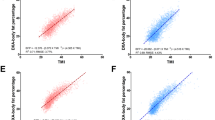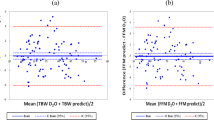Abstract
OBJECTIVE: Obesity, as measured by body mass index, is highly prevalent in Native American children, yet there are no valid equations to estimate total body fatness for this population. This study was designed to develop equations to estimate percentage body fat from anthropometry and bioelectrical impedance as a critical part of Pathways, a multi-site study of primary prevention of obesity in Native American children.
DESIGN: Percentage fat was estimated from deuterium oxide dilution in 98 Native American children (Pima/Maricopa, Tohono O'odham and White Mountain Apache tribes) between 8 and 11 y of age. The mean fat content (38.4%±8.1%) was calculated assuming the water content of the fat-free body was 76%. Initial independent variables were height, weight, waist circumference, six skinfolds and whole-body resistance and reactance from bioelectrical impedance (BIA).
RESULTS: Using all-possible-subsets regressions with the Mallows C (p) criterion, and with age and sex included in each regression model, waist circumference, calf and biceps skinfolds contributed least to the multiple regression analysis. The combination of weight, two skinfolds (any two out of the four best: triceps, suprailiac, subscapular and abdomen) and bioelectrical impedance variables provided excellent predictability. Equations without BIA variables yielded r2 almost as high as those with BIA variables. The recommended equation predicts percentage fat with a root mean square error=3.2% fat and an adjusted r2=0.840.
CONCLUSION: The combination of anthropometry and BIA variables can be used to estimate total body fat in field studies of Native American children. The derived equation yields considerably higher percentage fat values than other skinfold equations in children.
This is a preview of subscription content, access via your institution
Access options
Subscribe to this journal
Receive 12 print issues and online access
$259.00 per year
only $21.58 per issue
Buy this article
- Purchase on Springer Link
- Instant access to full article PDF
Prices may be subject to local taxes which are calculated during checkout
Similar content being viewed by others
References
Troiano RP, Flegal KM, Kuczmarski RJ, Campbell SM, Johnson CL . Overweight prevalence and trends in children and adolescents Arch Pediatr Adolesc Med 1995 149: 1085–1091.
Jackson MY . Height, weight, and body mass index of Native American Indian School Children, 1990–1991 J Am Diet Assoc 1993 93: 1136–1140.
Broussard BA, Johnson A, Himes JH, Story M, Fichtner R, Hauck F, Bachman-Carter K, Hayes J, Frohlich K, Gray N, Valway S, Gohdes D . Prevalence of obesity in Native American Indians and Alaska Natives Am J Clin Nutr 1995 15: 35S–42S.
Rising R, Swinburn B, Larson K, Ravussin E . Body composition in Pima Indians: validation of bioelectrical resistance Am J Clin Nutr 1991 53: 594–598.
Stolarczyk LM, Heyward VH, Hicks VL, Baumgartner RN . Predictive accuracy of bioelectrical impedance in estimating body composition of Native American Women Am J Clin Nutr 1994 59: 964–970.
Lohman TG . Assessment of body composition in children Pediat Exercise Sci 1989 1: 19–30.
Boileau RA, Lohman TG, Slaughter MH, Ball TE, Going SB, Hendrix MK . Hydration of the fat-free body in children during maturation Hum Biol 1984 56: 651–666.
Conway JM, Sadijimin T, Dibley MJ, Kjolhede CL, Caballero B . Infrared spectroscopy for deuterium in infant's urine after D20 administration to the mother: comparison with isotope ratio mass spectrometry Am J Clin Nutr 1984 40: 1123–1130.
Lukaski HC, Johnson PE . A simple, inexpensive method of determining total body water using a tracer dose of D2O and infrared absorption of biological fluids Am J Clin Nutr 1985 41: 363–370.
Wong WWL, Klein PD . Deuterium and oxygen-18 measurements on microliter samples of urine, plasma, saliva and human milk Am J Clin Nutr 1987 45: 905–912.
Schoeller DA, Santen EV, Peterson DW, Dietz W, Jaspan J, Klein PD . Total body water measurement in humans with 180 and 2H labeled water Am J Clin Nutr 1980 33: 2686–2693.
Lohman TG, Roche AF, Martorell R (eds) . Anthropometric standardization reference manual Human Kinetics: Champaign, IL 1988.
Shorr IH . How to weigh and measure children. US Department of Technical Cooperation for Development and Statistical Office: New York 1986.
Houtkooper LB, Going SB, Lohman TG, Roche AF, VanLoan M . Bioelectrical impedance estimation of fat-free body mass in children and youth: a cross-validation study J Appl Physiol 1992 72: 366–373.
Efron B . The jackknife, The bootstrap and other resampling plans. Society for Industrial and Applied Mathematics JW Arrowsmith Ltd 1982, pp49–59.
Guo S, Roche AF, Houtkooper LB . Fat-free mass in children and young adults predicted from bioelectrical impedance and anthropometric variables Am J Clin Nutr 1989 50: 435–443.
Slaughter MH, Lohman TG, Boileau RA, Horewill CA, Stillman RJ, VanLoan MD, Bemben DA . Skinfold equations for estimation of body fatness in children and youth Hum Biol 1988 60: 709–723.
Houtkooper, LB, Lohman TG, Going SB, Howell WH . Why bioelectric impedance analysis should be used for estimating adiposity. Bioelectric Impedance Technology Assessment Conference Am J Clin Nutr 1996 64 (Suppl): 4365–4485.
Goran MI, Kaskoun M, Johnson R, Martinez C, Kelly B, Hood V . Energy expenditure and body fat distriubtion in Mohawk children Pediatrics 1995 95: 89–95.
Haschke F . Body composition of adolescent males. Part 2. Body composition of male reference adolescents Acta Paediat Scand 1983 307 (Suppl): 13–23.
Fomon SJ, Haschke F, Ziegler EE, Nelson SE . Body composition of reference children from birth to age 10 years Am J Clin Nutr 1982 35: 1169–1175.
Lohman TG . Advances in body composition assessment. Current issues in Exercise Science Series, Monograph 3 Human Kinetics: Champaign, IL 1992.
Baumgartner RM, Heymsfeld SB, Lichtma S, Wang J, Pierson RN Jr . Body composition in elderly people: effect on criterion estimates on predictive equations Am J Clin Nutr 1991 53: 1345–1353.
Heitmann BL . Prediction of body water and fat in adult Danes from measurement of electrical impedance. A validation study Int J Obes 1990 14: 789–802.
Svendsen OL, Haarbo J, Heitmann BL, Gotfredsen A, Christiansen C . Measurement of body fat in elderly subjects by dual-energy X-ray absorptiometry, biolelectrical impedance, and anthropometry Am J Clin Nutr 1991 53: 1117–1123.
Lohman, TG . Skinfolds and body density and their relation to body fatness: a review Hum Biol 1981 53: 181–225.
Graves JE, Pollock ML, Calvin AB, VanLoan MD, Lohman TG . Comparison of different bioelectrical impedance analyzers in the prediction of body composition Am J Hum Biol 1989 1: 603–611.
Segal KR, VanLoan M, Fitzgerald PI, Hodgerson JA, Van Itallie TB . Lean body mass estimation by bioelectrical impedance analysis: A four-site cross-validation study Am J Clin Nutr 1988 47: 7–14.
Kushner RF, Schoeller DA, Field CR, Danford L . Is the impedance index (ht2/R) significant in predicting total body water? Am J Clin Nutr 1992 56: 835–839.
Williams DP, Going SB, Lohman TG, Harsha DW, Sathanur RS, Webber LS, Berenson GS . Body fatness and risk for elevated blood pressure, total cholesterol, and serum lipoprotein ratios in children and adolescents Am J Public Health 1992 82: 358–363.
Lukaski HC . Biological indexes considered in the derivation of the bioelectrical impedance analysis Am J Clin Nutr 1996 64: 397S–404S.
Acknowledgements
We acknowledge the skilled technical assistance of D Nelson, K Booth, J White, J Palo, and S Levin. We are grateful for the collaborative contributions of B Broussard and the expertise for deuterium oxide analysis provided by K Schultze. We are also grateful for the cooperation of the Gila River and Tohono O'odham communities and the White Mountain Apache Indian community in Arizona, especially the children whose participation made this study possible. This work was supported by the National Heart, Lung and Blood Institute, NIH.
Author information
Authors and Affiliations
Rights and permissions
About this article
Cite this article
Lohman, T., Caballero, B., Himes, J. et al. Estimation of body fat from anthropometry and bioelectrical impedance in Native American children. Int J Obes 24, 982–988 (2000). https://doi.org/10.1038/sj.ijo.0801318
Received:
Revised:
Accepted:
Published:
Issue Date:
DOI: https://doi.org/10.1038/sj.ijo.0801318
Keywords
This article is cited by
-
Factors Involved in the Evolution of the Basal Metabolic Rate over 30 Months After Roux-en-Y Gastric Bypass
Obesity Surgery (2023)
-
Equations based on anthropometric measurements for adipose tissue, body fat, or body density prediction in children and adolescents: a scoping review
Eating and Weight Disorders - Studies on Anorexia, Bulimia and Obesity (2022)
-
Concurrent exercise training effect on salivary immunoglobulin A and alpha-amylase in children with cerebral palsy
German Journal of Exercise and Sport Research (2021)
-
Nationally representative equations that include resistance and reactance for the prediction of percent body fat in Americans
International Journal of Obesity (2017)
-
Body composition during growth in children: limitations and perspectives of bioelectrical impedance analysis
European Journal of Clinical Nutrition (2015)



